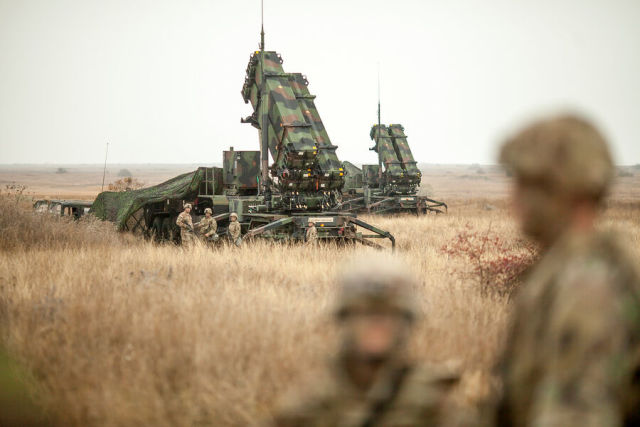Colonel Khodarenok told about the features of anti-aircraft weapons that the West transfers to the Armed Forces of Ukraine
The United States and NATO countries are increasing the supply of anti-aircraft weapons to Ukraine. In particular, these are NASAMS and Skyguard Aspide complexes. Why in the future it is impossible to exclude the supply of other types of equipment - in the author's material of the military observer "Gazeta.Ru" by Mikhail Khodarenka.
The transfer to Ukraine of the NASAMS anti-aircraft missile system (SAM), developed by the Norwegian company Kongsberg Defense and Aerospace in cooperation with the American company Raytheon Technologies, marks the beginning of the transition of the missile forces of Ukraine from Russian S-300 systems to Western-style SAM/SAMS.
The combat use and operation of Russian anti-aircraft missile weapons in units and formations of the air defense of Ukraine is becoming more and more difficult every day. Stocks of anti-aircraft guided missiles are coming to an end (and there is no own production in Ukraine), the necessary spare parts, tools and accessories are running out.
The transferred samples are not an outdated technique, as can often be heard, but the newest and its potential cannot be underestimated.
The same NASAMS is currently being used to guard the airspace over the White House and the Pentagon, which clearly indicates the confidence of the US military and politicians in this system. Among the foreign buyers of these SAMs are Spain, the Netherlands, Norway, Finland, Lithuania. Hungary and India have recently been added to them.
Other NATO countries are not far behind the United States. For example, the Spanish Ministry of Defense is already completing the delivery to Kiev of the Aspide short-range anti-aircraft missile system, which the Spanish army has replaced with another, more advanced NASAMS II system.
The Skyguard Aspide system is an Italian-Swiss production. Previously, it was manufactured under the head role of the Italian company Selenia, then became part of Alenia Aeronautica, whose rocket division became part of the Italian branch of the European association MBDA. With a mass of 228 kg and a length of 3.63 m, the Aspide Mk 1 missile has an official firing range of up to 20-25 km and an altitude reach of up to 8 km .
As for the recent statements of the Spanish press (La Vanguardia newspaper) about the "impossibility of transferring Patriot systems to Ukraine," then at least it looks strange that possible decisions of Washington are voiced by Madrid.
In particular, the publication La Vanguardia notes that the operation and combat use of Patriot air defense systems requires the presence of "highly qualified specialists" in Ukraine. In this logic, we have to assume that similar work with the NASAMS air defense system does not require highly qualified specialists. This, of course, is nonsense and absurd.
And, finally, the main thing is that when some sources state the absolute impossibility of transferring certain types of weapons, military and special equipment to Ukraine, then such assessments should be treated with great caution, and no long-term calculations and forecasts should be based on this.
In this case, one should always be guided by the example of Germany. Berlin has radically changed its policy regarding the supply of weapons and military equipment to Ukraine in a fairly short period of time.
If at the beginning of the special operation it was said about the transfer by Germany to the armed forces of Ukraine of exclusively non-lethal equipment (helmets, bulletproof vests), now the list of supplies includes Panzerhaubitze 2000 self-propelled howitzers and spare parts for them, unmanned aerial vehicles, armored personnel carriers, Gepard anti-aircraft self-propelled guns, M270 multiple rocket launchers in the MARS variant.
Deliveries to Ukraine of the Patriot complex are quite real. And this is the height of the defeat up to 20 km and a range of up to 100 km. This is a serious threat to Russian aircraft.
The opinion of the author may not coincide with the position of the editorial board.
Biography of the author:
Mikhail Mikhailovich Khodarenok is a military columnist for the newspaper.Ru", retired colonel.
He graduated from the Minsk Higher Engineering Anti-Aircraft Missile School (1976), the Military Air Defense Command Academy (1986).
Commander of the S-75 anti-aircraft missile division (1980-1983).
Deputy Commander of the anti-aircraft missile regiment (1986-1988).
Senior Officer of the General Staff of the Air Defense Forces (1988-1992).
Officer of the Main Operational Directorate of the General Staff (1992-2000).
Graduated from the Military Academy of the General Staff of the Armed Forces of Russia (1998).
Columnist of "Nezavisimaya Gazeta" (2000-2003), editor-in-chief of the newspaper "Military-Industrial Courier" (2010-2015).
Mikhail Khodarenok

